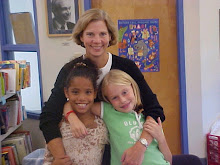How does the magic skill - reading - come about? At Parker, it comes from children's desire to understand the world around them - the best motivator for an emerging reader.
Through stories read to them, and stories they tell; from describing a bird's feather to deciphering a friend's message of the day, Parker kindergarteners and first graders acquire the tools and the desire to read, to write, and to communicate. And they master it on their own timeline, just like when they learned to talk or walk.
Children practice translating sounds into letters and words: phonics. They keep personal "word walls": sight memory. They interpret the meaning of a story or the facts in a research book because they really, really, really want to know all about it: purpose. They publish a book about butterflies or a poster on poultry farmers for a Show of Work: audience.
In our K-1 classrooms, reading is bound up with everything that happens: the morning meeting, research, science and social studies, or writing and performing a play. And it is formally scheduled for over an hour every day.
Over the last two summers our language arts teachers revised our curriculum with specialist, Miriam Raider-Roth, a professor at the University of Cincinnati and a former Parker parent. They consulted state and national guidelines and adapted them to our own high standards. They published the school's curricular document and now it is on our website.
Click here and scroll to bottom.
I hope you will take a look, so when someone asks you why Parker kids aren't filling out workbook sheets to learn to "read" in kindergarten to take state tests - you can say with confidence, "Sooner isn't better."













.JPG)







